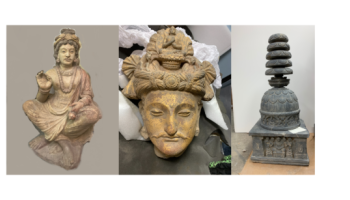Kapoor was arrested in 2011 at a German airport for smuggling and was extradited to India in 2012 where he is currently on trial. The U.S. also issued an arrest warrant for Kapoor in 2012 and in July 2020, the D.A.'s Office filed extradition paperwork for Kapoor and his co-defendants.
Kapoor and his team of conspirators have been indicted for the looting, illegal exportation, and sale of ancient art and cultural heritage from Afghanistan, Cambodia, India, Indonesia, Myanmar, Nepal, Pakistan, Sri Lanka, Thailand, and other nations.
The criminal network smuggled art looted from Asia and sold the pieces in Kapoor’s gallery ‘Art of the Past’ on Manhattan’s Madison Avenue. From 2011 to 2021 the New York authorities and Homeland Security Investigations (HSI) recovered more than 2,500 items trafficked by Kapoor and his team.
Among the artifacts returned to India last week were a bronze Shiva Nataraja, from the 12th century, valued at $4 million. The statue was stolen in the 1960s from a temple. India also got back a bronze Nandikesvara and Kankalamurti, which were stolen from the Sri Narasinganata Temple in May 1985.
“Homeland Security Investigations is committed to combating the plundering of cultural heritage and the illicit trafficking of cultural property. When items like these are stolen and looted, we are determined to make things right, and ultimately return them home where they belong,” said HSI’s New York Acting Special Agent in Charge Ricky J. Patel.
The illegal antiquities trade is a multi-billion dollar global industry, according to a 2018 report by Standard Charter Bank. Its beneficiaries are not just high society art aficionados like Kapoor and his Manhattan clients, but often the trade is a major funding source for criminal and militant groups on the supply side.






